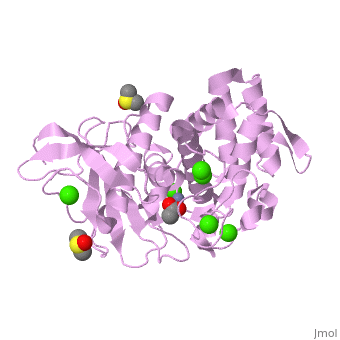Thermolysin (TML) is a thermostable metalloproteinase enzyme from Bacillus thermoproteolyticus. It catalyzes the hydrolysis of peptide bonds containing hydrophobic residues. Thermolysin is a well researched metalloprotease containing (click this!) and the amino acids His-Glu-X-His-His as its catalytic center. , holding it fast, while stabilize the substrate protein which will be cleaved into two smaller proteins.[1][2]. See Metalloproteases and Matrix metalloproteinase for discussion.
3D Structures of Thermolysin
Updated on 24-September-2014
Thermolysin
2whz, 3fvp, 3dnz, 3do0, 3do1, 3do2, 2g4z, 2a7g, 1gxw, 1kei, 1l3f, 1tlx, 2tlx, 8tln, 3p7p, 3p7q, 3p7r, 3p7s, 3p7t, 3p7u, 3p7v, 3p7w, 3zi6 – TML
3ls7, 4ow3 - TML residues 233-548
1trl - TML residues 255-316 – NMR
3fxs, 3fbo, 3eim, 1lna, 1lnb, 1lnc, 1lnd, 1lne, 1lnf - TML residues 233-548+metal ion replacing Ca
TML+transition state analog
1tlp, 1tmn, 2tmn, 4tmn, 5tmn – TML+transition state analog
TML+ amino acid
1kl6 – TML+ alanine
4m65 – TML + asparagine
3qgo – TML + phenylalanine methyl ester
3qh1 – TML + benzyloxycarboxyl- aspartate
3qh5 – TML + benzyloxycarboxyl- aspartate + phenylalanine methyl ester
TML+ dipeptide
2wi0, 3tmn – TML+ dipeptide
3fgd - TML residues 233-548+dipeptide
TML+inhibitor
1fjo, 1fj3, 1fjq, 1fjt, 1fju, 1fjv, 1fjw, 4tli, 5tli, 6tli, 7tli, 8tli, 1tli, 2tli, 3tli – TML soaked in organic solvents
3fv4, 3fxp, 3flf, 3fb0, 3fcq, 3f28, 3f2p, 4mtw, 4mwp, 4mxj, 4mzn, 4n4e, 4n5p, 4n66, 4oi5 – TML residues 233-548+inhibitor
3fwd, 3for, 1y3g, 1zdp, 1z9g, 1pes, 1pe7, 1pe8, 1os0, 1kto, 1ks7, 1kro, 1kr6, 1kkk, 1kjo, 1kjp, 1qf0, 1qf1, 1qf2, 1hyt, 1thl, 6tmn, 7tln, 4tln, 5tln, 1pe5, 3ms3, 3msa, 3msf, 3msn, 3n21, 3nn7, 3t73, 3t74, 3t87, 3t8c, 3t8d, 3t8f, 3t8g, 3t8h, 4h57, 4d9w, 4d91 – TML+inhibitor
3ssb – TML + Impi-α
3t2h – TML + trimethylamine oxide
3t2i – TML + sarcosine
3t2j – TML + betaine

